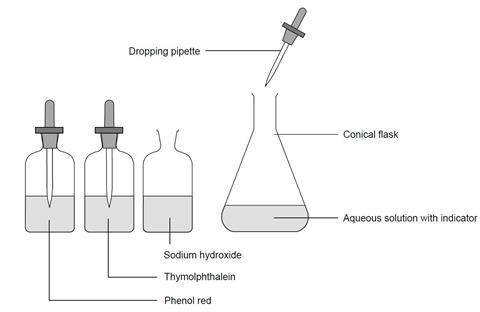In this experiment, students use their own exhaled breath to explore the reaction between carbon dioxide and water.
This is a relatively brief and straightforward exploration of the reaction of carbon dioxide and water at a simple level, which should take no more than 15 minutes.
When carbon dioxide reacts with water a weak acid is formed. Carbon dioxide present in exhaled air is blown into a flask containing an indicator sensitive to small changes of pH in the appropriate region of the pH scale, and the consequent colour changes observed and recorded. The equation for the reaction between carbon dioxide and water may be introduced for appropriate students.
If students have not yet met the compositions of inhaled and exhaled air, this experiment can serve as part of the learning sequence for the topic of breathing and respiration in an introductory science course, using an appropriately elementary approach to the chemistry involved.
For students who have already covered the topic of breathing and respiration, and know that carbon dioxide is a significant component of exhaled air, the focus in this experiment can be transferred to the nature of the chemical reaction (other related topics could be acid rain, gas liquid reactions or indicators).
The equation for the reaction between carbon dioxide and water may be introduced for appropriate students.
Equipment
Apparatus
- Eye protection
- Conical flask, 250 cm3, x2
- Indicator bottles with dropping pipettes, x3
Chemicals
- Ethanol (IDA – Industrial Denatured Alcohol) (HIGHLY FLAMMABLE, HARMFUL)
- Thymolphthalein indicator solution (HIGHLY FLAMMABLE), access to small bottle with dropper
- Phenol red indicator solution (HIGHLY FLAMMABLE), access to small bottle with dropper
- Sodium hydroxide solution, 0.4 M (IRRITANT), small bottle with dropper
- Distilled (or deionised) water, 125 cm3, x2
Health, safety and technical notes
- Read our standard health and safety guidance.
- Wear eye protection throughout.
- Phenol red indicator – see CLEAPSS Hazcard HC032. The indicator may be purchased as a solid reagent or as a ready-made solution in ethanol. The solution may be made from the solid reagents by preparing a 5% w/v solution in ethanol (IDA). If 30 cm3 or 60 cm3 dropping bottles with integral dropping pipettes are available, these are ideal for dispensing the indicator solutions. While phenol red itself is not flammable, its solution in ethanol is highly flammable.
- Thymolphthalein indicator – see CLEAPSS Hazcard HC032. The indicator may be purchased as a solid reagent or as a ready-made solution in ethanol. The solution may be made from the solid reagents by preparing a 5% w/v solution in ethanol (IDA). If 30 cm3 or 60 cm3 dropping bottles with integral dropping pipettes are available, these are ideal for dispensing the indicator solutions. While thymolphthalein itself is not flammable, its solution in ethanol is highly flammable.
- Ethanol (IDA – Industrial Denatured Alcohol), CH3CH2OH(l), (HIGHLY FLAMMABLE, HARMFUL) – see CLEAPSS Hazcard HC040A.
- Sodium hydroxide solution, NaOH(aq), (IRRITANT at concentration used) – see CLEAPSS Hazcard HC091a and CLEAPSS Recipe Book RB085.
Procedure

Activity 1
- Place about 125 cm3 of water in a 250 cm3 conical flask.
- Add five or six drops of thymolphthalein indicator to the water.
- Add just enough sodium hydroxide solution (about two or three drops) to produce a blue colour.
- Talk or blow gently into the flask – ie add the carbon dioxide.
- Continue adding the carbon dioxide until a colour change is observed.
Activity 2
- Place about 125 cm3 of water in a 250 cm3 conical flask.
- Add one or two drops of phenol red to the water.
- Add two drops of sodium hydroxide solution to produce a red solution.
- Talk or blow gently into the flask – ie add carbon dioxide.
- Continue adding the carbon dioxide until a colour change is observed.
Questions for the class
- Why does the colour change not occur instantly?
- What is the reason for adding a few drops of sodium hydroxide solution (NaOH) before each experiment?
Answers to questions
- The amount of carbon dioxide in each breath is small, so it takes a lot of breaths to react with the alkali.
- To ensure the solution is slightly alkaline at the beginning and to neutralise any CO2 or any other acid initially present.
Teaching notes
Straws are not necessary for blowing exhaled air into the flask; simply breathing or speaking into the flask is sufficient to cause the indicator to change colour.
Phenol red indicator changes from yellow to red over the pH range 6.8–8.4. Thymolphthalein (the alternative bromothymol blue could also be used) changes from blue (alkaline) to colourless (acid) over the pH range 9.3–10.5. See CLEAPSS Recipe Book RB000, which also covers bicarbonate indicator solution.
Eventually sufficient carbon dioxide from the students’ breath dissolves and produces enough acid in the solution to change the colour of the indicator:
CO2(aq) + H2O(l) ⇌ H+(aq) + HCO3–(aq)
CO2 also reacts with NaOH. This reaction produces the less alkaline Na2CO3:
2NaOH(aq) + CO2(g) → Na2CO3(aq) + H2O(l)
The equilibrium between carbon dioxide and water can be reversed by heating the weakly acidic solution to just below boiling. The solubility of carbon dioxide in water decreases as the temperature is raised, and it is driven off into the atmosphere. The concentration of dissolved carbon dioxide therefore drops, causing the equilibrium to shift to the left and the indicator colour to change back to red. On cooling the solution and blowing exhaled breath into the flask again, the sequence can be repeated.
More resources
Add context and inspire your learners with our short career videos showing how chemistry is making a difference.
Additional information
This is a resource from the Practical Chemistry project, developed by the Nuffield Foundation and the Royal Society of Chemistry.
Practical Chemistry activities accompany Practical Physics and Practical Biology.
© Nuffield Foundation and the Royal Society of Chemistry


















No comments yet